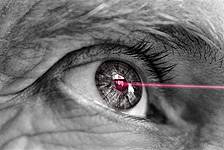Light sensitivity affects up to 20% of contact lens wearers. Could scleral lenses be the answer?
For most people, regular soft contact lenses are a convenient way to correct vision. However, for those with very dry eyes or corneal conditions like keratoconus, these standard lenses may not be the best option.
Scleral contact lenses are a successful alternative for those with ‘hard-to-fit’ eyes, and may also be the perfect solution if you suffer from light sensitivity.
What are scleral contact lenses?
Scleral lenses are larger in diameter than regular hard (RGP) contact lenses and rest on the white part of the eye, the sclera. Their large surface area allows them to vault over the cornea, where standard lenses sit, and avoid contact with the sensitive corneal tissue.
Scleral lenses contain a reservoir of fluid located between the lens and the surface of the eye which provides optimal comfort and visual clarity throughout the day.
Scleral lenses are customized to ensure a perfect fit for each individual eye, and can be beneficial for patients with:
- Keratoconus
- Dry eye syndrome
- Irregular/excessive astigmatism
- Sjorgen’s syndrome
- Corneal abnormalities
- Post-LASIK surgery
If you are experiencing light sensitivity, schedule an eye exam with an eye doctor near you.
SEE RELATED: How to Insert and Remove Scleral Lenses
What is light sensitivity?
When the cornea is irregularly shaped, light that enters the eye is unable to be focused directly onto the retina.
An irregular shaped cornea can result in glare and light sensitivity, causing discomfort in brightly-lit environments.
Patients suffering from photophobia may see halos around lights or experience cloudy vision while driving at night. Bright fluorescent lights and computer screens can also trigger eye pain and significantly impact work productivity.
How do scleral lenses reduce light sensitivity?
Light sensitivity is a common side effect of keratoconus and dry eye syndrome, among other eye conditions.
Scleral lenses are designed to provide a smooth corneal surface — enabling light to focus accurately onto the retina.
Additionally, due to their larger size, scleral lenses have a wider optic zone that allows for a wider view of peripheral visual field and further reduction of glare and light sensitivity.
Tips to reduce symptoms of light sensitivity
Implementing the following suggestions can also help to relieve symptoms of glare and increased light sensitivity:
- Wear dark sunglasses when venturing outdoors
- Consider installing filters on fluorescent light sources
- Take frequent breaks when using a digital device
- Turn mirrors away from light sources and keep windows clean and streak-free
- Consider removing reflective surfaces from your home altogether
- Speak with your optometrist about whether scleral contact lenses can help you
How long does it take to adjust to scleral contact lenses?
Scleral lenses are generally quite comfortable, but in some cases, it could take up to 10 days to get used to your new lenses. Your optometrist will guide you on how to shorten the adjustment period and make scleral lens wear as comfortable as possible.
If you are experiencing light sensitivity, schedule an appointment with an eye doctor near you to determine if you can benefit from scleral lenses.
LEARN MORE: Guide to Contact Lenses
If you or a family member experience light sensitivity or has been diagnosed with any corneal condition, scleral contact lenses might be the optimum solution.









